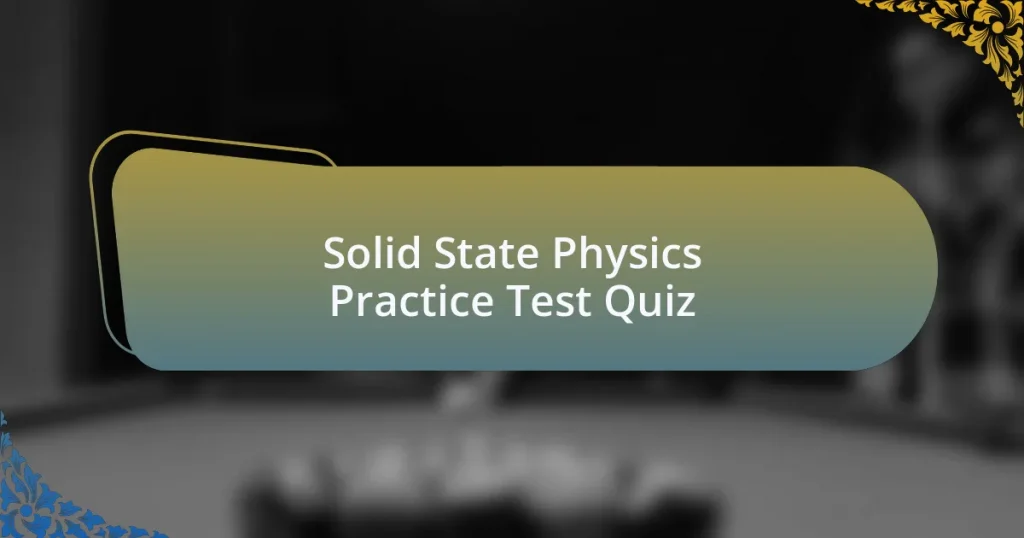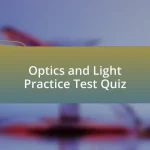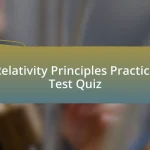Start of Solid State Physics Practice Test Quiz
1. What is the primary characteristic of solids?
- Solids can flow and take the shape of their container.
- Solids have no fixed volume or shape.
- Solids easily change their shape when pressed.
- Solids resist the force applied to their surface.
2. How many states of matter are there in physics?
- Two (solid and liquid).
- Four (solid, liquid, gas, and plasma).
- Five (solid, liquid, gas, plasma, and Bose-Einstein condensate).
- Three (solid, liquid, and gas).
3. What is solid-state physics?
- The study of liquids and gases in motion.
- The analysis of biological systems at a molecular level.
- The branch of physics that deals with the study of rigid solid matter.
- The examination of gaseous chemical reactions.
4. What are the two main types of solids?
- Soluble and insoluble solids.
- Crystalline and amorphous solids.
- Transparent and opaque solids.
- Solid and gas phases.
5. Which type of solid has an irregular structure?
- Superconducting solid
- Crystalline solid
- Metallic solid
- Amorphous solid
6. What is the smallest portion of the lattice?
- Lattice point
- Atomic layer
- Crystal face
- Unit cell
7. What is a property of an ionic compound?
- High boiling and melting points.
- Low conductivity in the solid state.
- Irregular atomic structure.
- Soft and malleable.
8. In which state do ionic compounds conduct electricity?
- In gaseous state.
- In molten state.
- In solid-state.
- In liquid state.
9. How many possible ways are there to arrange points in space lattices?
- 10 possible ways
- 16 possible ways
- 12 possible ways
- 14 possible ways
10. What property is true for a metalloid?
- Poor conductors of heat and electricity.
- High melting points only.
- Excellent insulators of electricity.
- Only conductive in liquid form.
11. What is the shape of a Landau level in k-space?
- Elliptical
- Circular
- Parabolic
- Hyperbolic
12. What is the critical wavelength of a photon capable of ejecting an electron from metal?
- ∼15 nm
- ∼20 nm
- ∼10 nm
- ∼5 nm
13. What physical feature corresponds to truncation of the Ewald sum in ionic solids?
- Molecular bond length.
- Ion radius.
- Crystal surface.
- Lattice vibration.
14. What are the correct values for expressing cubic lattice structures?
- x = 1, y = 2, z = 3.
- x = y = z = 0.5.
- x = y = z = 1.
- x = 2, y = 2, z = 2.
15. What is the effective mass at very low band filling?
- Constant across all conditions.
- A linear function of temperature.
- A function of both s and t.
- Zero for all systems.
16. Why can the density of states be written as D(ϵ) = ∫∫ dkx dk y δ(εk − ϵ)?
- It is based on quantum entanglement of particles in solids.
- It derives from thermodynamic principles related to states.
- Geometrical argument in k-space that explains the limits of integration.
- It explains the temperature dependence of solid materials.
17. What is the radius of a tungsten atom in a body-centred cubic unit cell with an edge of 316.5 pm?
- 118.25 pm
- 137.04 pm
- 121.50 pm
- 154.78 pm
18. What type of stoichiometric defect occurs with equal cations and anions missing from a crystal?
- Schottky defect
- Interstitial defect
- Frenkel defect
- Vacancy defect
19. How does a Schottky defect affect crystal density?
- The density of the crystal remains the same.
- The density of the crystal oscillates.
- The density of the crystal decreases.
- The density of the crystal increases.
20. Which ionic substances commonly exhibit Schottky defects?
- MgO
- CaF2
- KCl
- NaCl
21. What is the coordination number of an atom in a hexagonal close-packed structure?
- 4
- 8
- 6
- 12
22. Which element should be doped with silicon for a p-type semiconductor?
- Phosphorus
- Arsenic
- Gallium
- Antimony
23. What is a property of an amorphous solid?
- Crystalline arrangement.
- Irregular structural pattern.
- Definite geometric shape.
- High thermal conductivity.
24. In which lattice structure does copper crystallize?
- Hexagonal close-packed (hcp)
- Face-centred cubic (fcc)
- Body-centred cubic (bcc)
- Simple cubic
25. What is the radius of a sodium atom in a body-centred cubic unit cell with an edge length of 4.3 × 10^-8 cm?
- 2.15 × 10^-8 cm
- 0.93 × 10^-8 cm
- 1.86 × 10^-8 cm
- 0.75 × 10^-8 cm
26. What is the unit cell side length of aluminum crystallizing in face-centred cubic structure with a 125 pm radius?
- 375 pm
- 500 pm
- 250 pm
- 125 pm
27. What does the vacancy defect demonstrate in a crystal?
- It demonstrates the melting point in a crystal structure.
- It demonstrates the thermal conductivity in a crystal structure.
- It demonstrates the vacancy defect in a crystal structure.
- It demonstrates the atomic radius in a crystal structure.
28. What is the packing efficiency of a simple cubic lattice?
- 33%
- 52%
- 60%
- 75%
29. What is a property of a metalloid?
- Semi-conductors of electricity
- Excellent conductors of heat
- Complete insulators
- Non-conductors of heat
30. What is the critical wavelength of a photon capable of ejecting electrons from metal?
- ∼10 nm
- ∼50 nm
- ∼20 nm
- ∼5 nm
Quiz Completed Successfully!
Congratulations on completing the Solid State Physics Practice Test! Engaging with these questions has not only tested your knowledge but also deepened your understanding of key concepts in solid state physics. You may have discovered insights into crystal structures, electron behavior in solids, and the principles governing material properties. Each question offered a chance to reflect and reinforce your comprehension of this important physics branch.
Through this quiz, you likely learned how vital solid state physics is to technology and materials science. It impacts everything from the development of semiconductors to understanding superconductivity. Recognizing the links between theoretical concepts and real-world applications can empower you as you continue your studies in physics.
We invite you to explore the next section on this page. It contains additional resources on Solid State Physics Practice Tests. This material will enhance your learning journey and prepare you even further for upcoming exams. Keep building on your knowledge, and let’s continue to unravel the fascinating world of solid state physics together!
Solid State Physics Practice Test
Understanding Solid State Physics
Solid state physics is the branch of physics that deals with the study of solid materials. This includes understanding their properties, behaviors, and interactions at the atomic and molecular levels. The discipline covers a wide range of topics, including crystallography, electronic properties, magnetism, and superconductivity. Mastery of these concepts is essential for solving advanced problems in solid state physics courses. Knowledge in this area provides a foundation for practical applications in materials science and nanotechnology.
Key Topics in Solid State Physics Practice Tests
Practice tests in solid state physics typically encompass several core topics. These include lattice structures, band theory, phonons, and the electrical and thermal properties of materials. Understanding the distinctions between conductors, insulators, and semiconductors is crucial. Furthermore, concepts of quantum mechanics often apply to solid state physics. Familiarity with these topics prepares students for exam questions and practical applications in the field.
Format of Solid State Physics Practice Tests
Solid state physics practice tests usually consist of multiple-choice questions, short answer questions, and problem-solving exercises. These formats assess both conceptual understanding and practical skills. Multiple-choice questions enable quick evaluation, while short answers foster in-depth exploration of topics. Problem-solving exercises challenge students to apply their knowledge. Each format provides valuable feedback on areas needing review, aiding effective test preparation.
Tips for Preparing for Solid State Physics Exams
Effective preparation for solid state physics exams involves a few strategic approaches. First, review lecture notes and textbooks to solidify understanding of key concepts. Practice problems are vital for honing problem-solving skills. Creating summary sheets for each topic can aid memory retention. Additionally, formulating study groups can encourage discussion and deepen comprehension. Regular review sessions can reinforce knowledge and boost confidence before the test date.
Resources for Solid State Physics Practice Tests
Several resources are available for solid state physics practice tests. Academic websites often provide sample questions and past exam papers. Textbooks frequently include problem sets with varying difficulties. Online platforms offer interactive quizzes to test knowledge in real-time. Utilizing these resources can improve understanding and performance. Consistent use of practice materials is essential for mastering the subject matter.
What is a Solid State Physics Practice Test?
A Solid State Physics Practice Test is an assessment tool designed to evaluate a student’s understanding of concepts in solid state physics. It typically includes questions on topics such as crystal structures, band theory, and semiconductor physics. The purpose of the test is to prepare students for exams by providing a simulation of potential test scenarios and types of questions. Such tests often reflect the format and difficulty level of formal assessments in the subject.
How can I prepare for a Solid State Physics Practice Test?
To prepare for a Solid State Physics Practice Test, students should review relevant study materials, including textbooks and lecture notes. They should actively solve practice problems and past exam papers to strengthen their understanding. Engaging in group study sessions can also enhance learning through discussion. Additionally, utilizing online resources and instructional videos can clarify complex topics and improve problem-solving skills.
Where can I find Solid State Physics Practice Tests?
Solid State Physics Practice Tests can be found through various educational platforms, university websites, and online forums dedicated to physics education. Some educational publishers offer collections of practice tests in solid state physics as part of their study guides. Moreover, academic apps and online learning platforms often provide access to practice questions for students preparing for physics exams.
When should I take a Solid State Physics Practice Test?
A Solid State Physics Practice Test should ideally be taken after completing major sections of the coursework. Taking the test shortly before the actual exam helps to reinforce knowledge and identify areas requiring further study. Scheduling practice tests periodically throughout the semester can also assist in continuous assessment of understanding and retention of the material.
Who can benefit from a Solid State Physics Practice Test?
Undergraduate and graduate students studying solid state physics or related fields can benefit from a Solid State Physics Practice Test. This includes physics majors, engineering students, and anyone preparing for advanced studies or professional exams in materials science and condensed matter physics. Instructors may also use these tests to gauge student progress and understanding of key concepts in the field.















